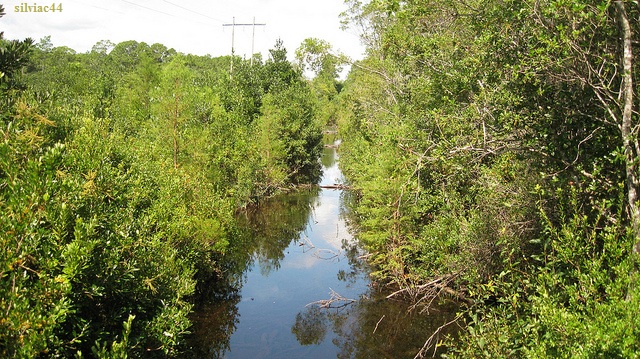With the sky an overcast of grey, at 11:45 a.m., on Wednesday, November 14, 2012, Professor Steven Watters was sitting at a table, in his home in Crestview, Florida, near the open back door, when he was shocked to see a “huge rhamphorhynchus like flying entity.” In our email communications, in his own words:
It was flying west to northeast close enough it could’ve been shot down. I . . . ran to the door and about turned white and lost my breath in disbelief. Had an estimated wingspan of 8-12 feet and a tail as long as its torso with a large bulb or lump at the tail very diamond shaped, no feathers and all colored the same whitish-grey color with a pointed beak. . . .
After it flew northeast past my location it landed on the very top of a tree about im guessing a 1/2 to 3/4 mile from where I’m standing . . . A few minutes later it disappeared from my view past the treeline continuing in its northeast direction.
Professor Watters kindly answered my questions:
Q: What was the closest distance between you and it, during its flight?
A: The closest distance between us was estimated 100 -150 feet during its flight.
. . . Q: At the closest distance it was to you, about how high was it?
A: The flight height was very low estimated 50 -70 foot just at or slightly above tree top level.
Q: For about how many seconds did you observe it, counting the time you watched it while it was in the tree?
A: It was observed for several minutes, no longer than 4 or 5 all together.
He was positive that there were no feathers.
I asked him, “Previous to your sighting on Wed, Nov 14, did you know anything about any report about a living pterosaur or ‘pterodactyl’ or modern dragon or ‘ropen?'” He answered:
No! I have never heard of such a thing, never considered seeing something I knew was extict and was nothing more than special effects in a movie. I thought it was just fairy tales or Irish drinking stories. Only after the sighting, during my research to prove myself mistaken did I realize there were actually other sightings of a similar prehistoric looking creature. During the learning process I discovered your blog and was compelled to actually share this experience with someone else, especially a non skeptic who wouldn’t just call me crazy or dismiss the revelance or possibility of the event.
I told him, “Thank you very much for providing these details. It does help the investigations.” I referred him to some online photographs of Frigate birds and he replied:
What I saw has no comparison to those pictures or any others [photos he has recenly looked at] during my own personal research. I appreciate your thorough and just approach. Sincerely my sighting’s appearance was featherless, mid length neck (especially if the frigate bird is what was meant by short neck, to me the frigate bird has no neck- just to clear that up from the previous question) and the color/hue of it was entirely greyish white with a true substantial large beak unlike the narrow [minuscule] frigate’s.
.

“Turkey Creek” – near Niceville (south of Crestview, Florida)
.
Pterosaurs in Southeastern United States
Late in 2008, I received an email from an eyewitness in Florida: “. . . something caught both of our attention, above our heads. It was a flying creature that flew over our heads towards my backyard . . .”
Pterosaur Tail Vane Orientation
How is the Rhamphorhynchoid tail vane oriented, horizontally or vertically? According to at least a couple of key eyewitnesses, it is horizontal.


